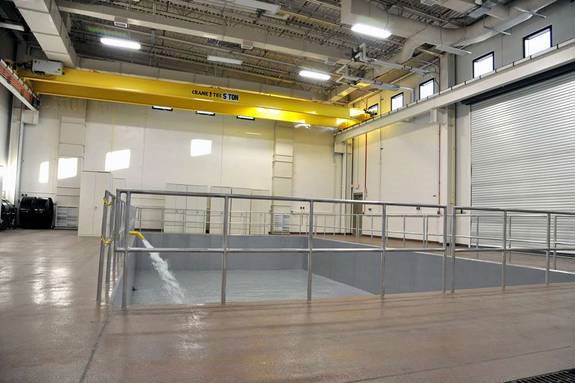Training place for secret US Navy robots
Tropical High Bay, affiliated to the Center for Automation Systems Research Laboratory, is a large greenhouse, simulating Southeast Asian rainforests and African deserts, with an average temperature of 27 degrees Celsius and humidity. 80% all year round.
This lab will be able to monitor the movements of battlefield robots while they find a way to survive through desert, coast and jungle simulation areas.

At the simulator of Southeast Asia rainforest, the
Robots will suffer heavy rain continuously for hours.
Around Tropical High Bay , a high-speed, automatic rotating video camera system has been installed to keep up with the movement of about 50 ground robots, tiny unmanned drones and even sergeants. Navy officer. This entire context can make you think of the science fiction film 'The Hunger Games' , a blockbuster about to release content about a reality TV show in the future, the only place. A winner is allowed to survive.
'Currently, our tracking system is the largest ever,' said Alan Schultz, Center Director for LiveScience.
Fortunately, unlike in movies, the US Navy only wants to test how much humans and robots can coordinate combat, instead of witnessing a life and death race.
Officially open from March 16, Tropical High Bay's largest training ground is about half the size of a football field, allowing researchers to change arbitrary simulated environments. They can insert background sounds, adjust the night light to the surface or even submerge an area of 12m2 with a depth of 10cm.

The remaining four practice areas will simulate different environments such as oceans, beaches, deserts, forests, waterfalls and stone walls. Robots will suffer 15cm / hour rain in the context of Southeast Asian jungle, while the desert context includes sandstorms, whirlwinds and stone walls to challenge robots.
In addition, there are small rooms inside the laboratory that use a retina monitor and a multitouch screen to study how humans control robots.
- The secret to English entry into the semifinals: Participate in training courses of the Royal Navy
- Russia reveals test of underground robot invisible 'Black Sea'
- America will replace dolphin detectors with robots
- Norway: The Russian Navy trains whales as 'special forces'
- Teach dolphins to use weapons
- Discovering the power of US destroyer USS Fitzgerald has docked in Da Nang port
- Fireplace training Russian secret astronauts
- Former FBI agent shared the secret to help you have a steel spirit
- Video: The US Navy develops robots to spy like sharks
- Project of turning the US Navy torpedo shark live
- Robot serving restaurant
- Google spent $ 1.5 million to study methods for learning robots like babies
 The most famous scientific failures in history
The most famous scientific failures in history Mysterious genius mechanic and the machine froze time
Mysterious genius mechanic and the machine froze time The son carries the 'bad gene' of genius Albert Einstein
The son carries the 'bad gene' of genius Albert Einstein Isaac Newton
Isaac Newton